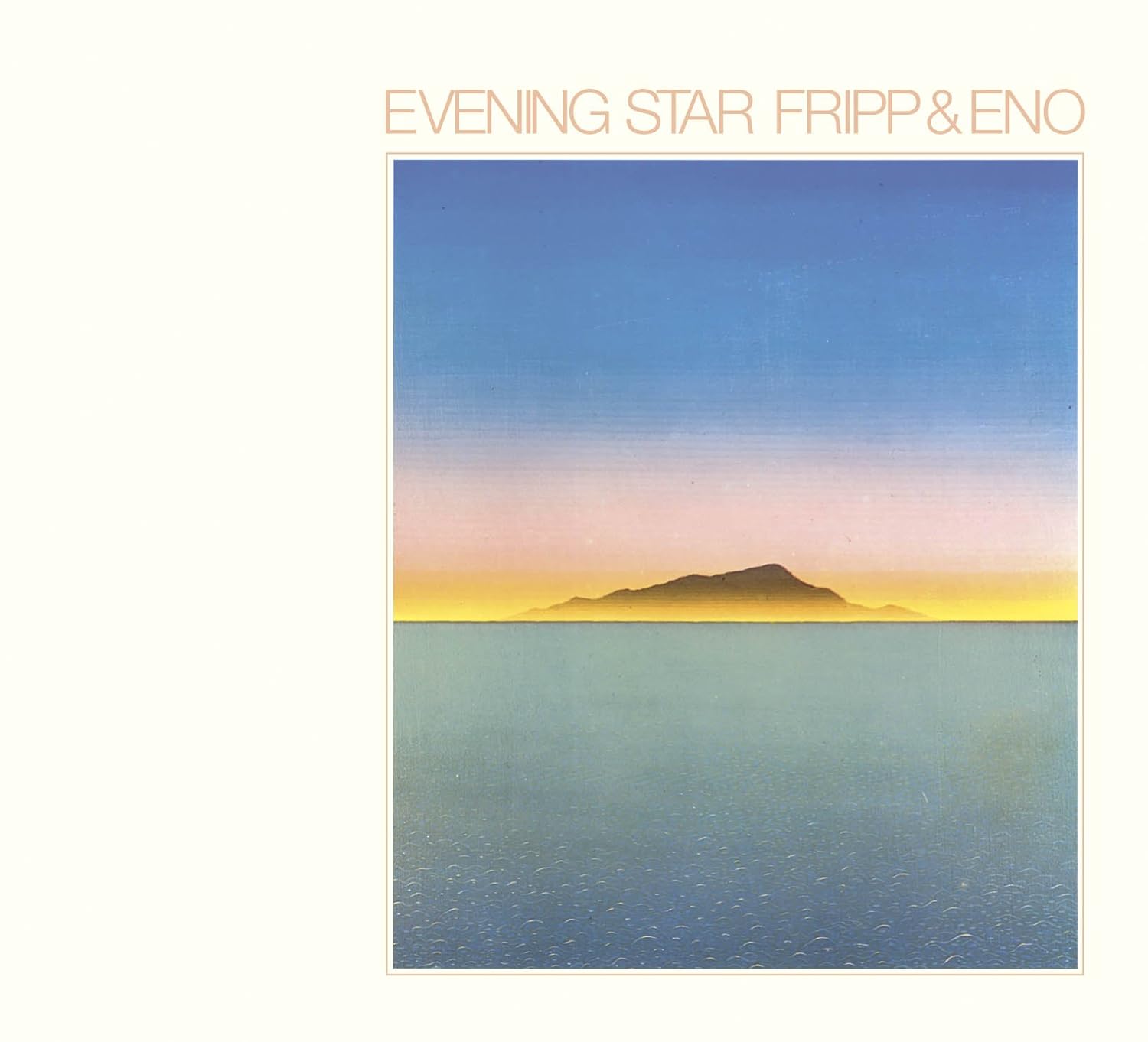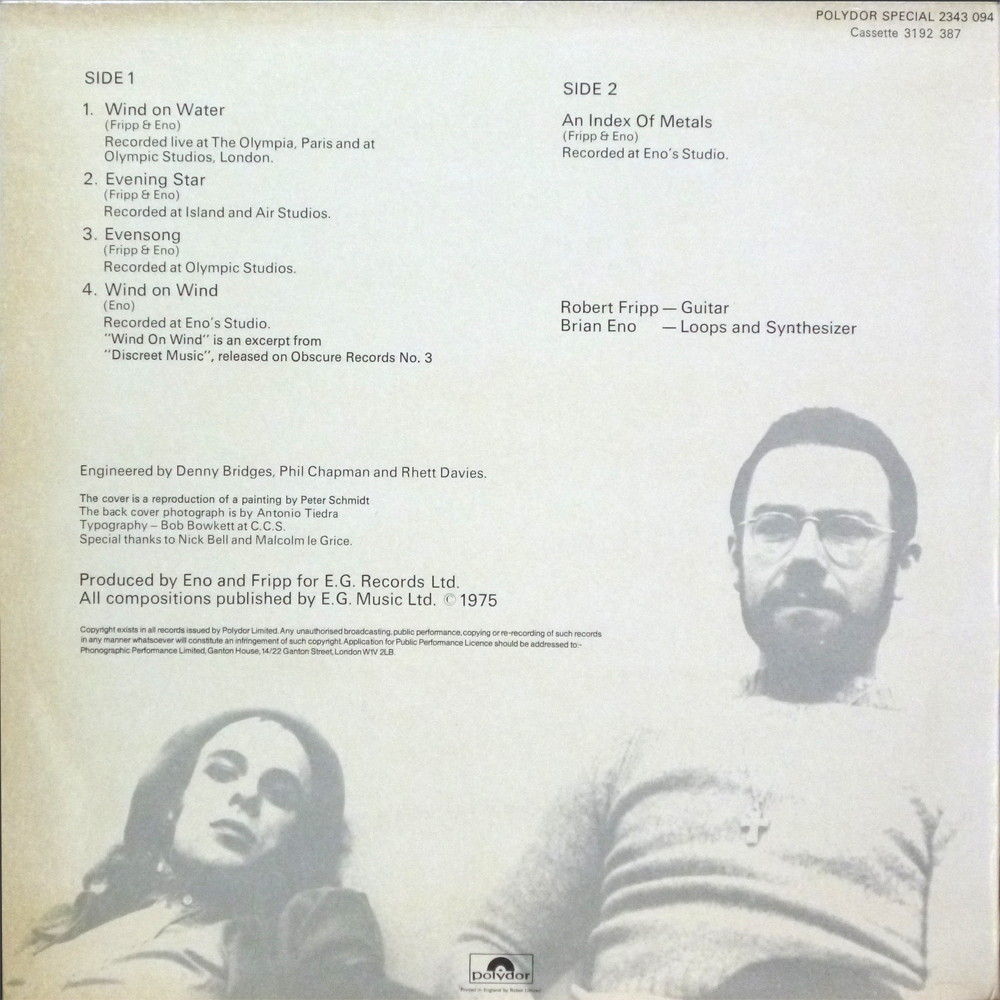Brian Eno and Robert Fripp layered treatments and textures into the meditative metallic melodies of this cosmic collaborative quietus. While they were still in their respective bands Roxy Music and King Crimson, the pair came together to create (No Pussyfooting) in 1972 utilizing tape loops and effects to create droning atmospheric soundscapes.
Fripp reveals: "I was first introduced to the technique, the actual way of using two tape machines together by Brian Eno seven years ago this month when we recorded side one of No Pussyfooting. A purely unofficial off-the-cuff informal meeting when for the first time I visited him socially at home in London. And the story behind this is Bryan Ferry auditioned for King Crimson in December 1970, and I turned him down but I suggested he go and visit David Enthoven, the manager of King Crimson, the "E" of EG, which he did, and consequently Roxy Music went into EG, and Eno was part of that establishment. So I bumped into Eno in the office a couple of times, and he invited me round. And I went round with my guitar and pedalboard for no reason that I can recall. In fact I had no idea why then. And he said, "Well, plug in." So I did. He didn't tell me how it worked. I simply intuited what was happening, and that was side one of No Pussyfooting. "
Eno elaborates: ''[When I said, 'I'm not a musician',] It was originally intended to indicate that my interest in music was in a set of ideas rather than in a set of techniques and it was intended to make a distinction between a body of opinion that saw music simply as a bundle of virtuosity and a bundle of skills which I don't think it is. Those skills are the vehicle for a set of ideas and it's the ideas that interest me. The obvious attraction of synthesizers for me was that there was no code of playing any of this new equipment and recording studio technology developed so quickly that nobody could say 'This is the right way to play a synthesizer'...There are things that you can do when you're naive that you can't do when you're not naive anymore. For example, you'll never learn to draw like a child again so you have to accept that you can't do that and you say what you'll do is just draw as you are.''
In the intervening years, Eno left Roxy Music and recorded several groundbreaking albums (Here Come the Warm Jets and Taking Tiger Mountain in 1974, and Another Green World and Discreet Music earlier in 1975); while Fripp disbanded King Crimson after a series of turbulent lineup changes. The duo came together again to produce Evening Star with Robert Fripp playing guitar and Brian Eno handling tape loops, synthesizer, and piano. "Wind on Wind" was an excerpt from Eno's Discreet Music. The cover painting for Evening Star was done by Peter Schmidt.
Eno: ''If you had a sign above every studio door saying 'This Studio is a Musical Instrument' it would make such a different approach to recording. You see my interest for quite a while has been in using the studio not as a machine that you feed input into and have it transferred onto a piece of tape. It's a means not simply of re-creating but of actually changing a sound. Sometimes it is even a source of that sound.''
The technique of guitar effects they developed became known as 'Frippertronics'. Fripp considers: "A lot of Frippertronics is ambient within Eno's definition of the term, that it's music as ignorable as it is listenable. There are two categories of Frippertronics, pure and applied. Applied is where it's used as an alternative to traditional orchestration, instrumentation, arrangement and so on and pure Frippertronics is where Frippertronics stands up as music in it's own right. Some of this is ambient and some of it has an imperative, a demand to be heard, that one must listen to it in order to catch the sense of it. So some of it is and some of it isn't...The most exciting response is where there's no excitement. That excitement is a cheap state of the release of tension, that a qualitative experience does not involve excitement, that it involves something quite different. It involves a sense of still, a sense of calm, a sense which is tangible but quite intangible and it's very difficult to express rationally. "
Eno expounds: "The function of being an artist for me is that it's an experimental area where I can test ways of thinking and operating and hopefully apply the results to real life. The advantage of testing them in an art context is that it doesn't really matter if you fail. You can afford to take risks that you wouldn't allow yourself in normal life. Having taken those risks and seen what freedoms they allow or what restrictions they impose, you are then free to extrapolate them into normal-life situation. That's what I think is the function of culture - to teach you new way of dealing with the world...We are no longer concerned with making horizontal music, by which I mean music that starts at point A, develops through point B and ends at point C in a kind of logical or semi logical progression. What's more interesting is constructing music that is a solid block of interactions. This then leaves your brain free to make some of those interactions more important than others and to find which particular ones it wants to speak to. One thing about vertical music is that you can enter it at any point and leave it at any point. You don't have to be in at the beginning."
http://brian-eno.net/
http://www.enoshop.co.uk/
https://www.dgmlive.com/
"Evening Star"
Evening Star
full album:
Brian Eno & Robert Fripp | Evening Star | Whole... by OssieBabb
All tracks written by Brian Eno and Robert Fripp, except "Wind on Wind" by Eno.
Side one
"Wind on Water" – 5:30
"Evening Star" – 7:48
"Evensong" – 2:53
"Wind on Wind" – 2:56
Side two
"An Index of Metals" – 28:36



No comments:
Post a Comment